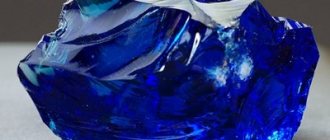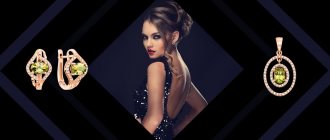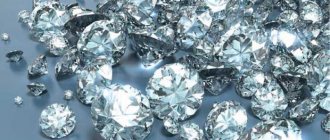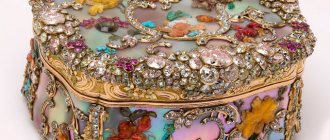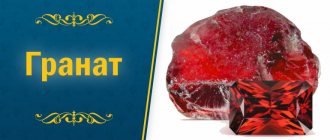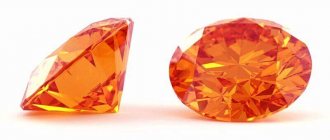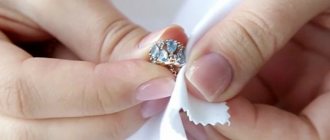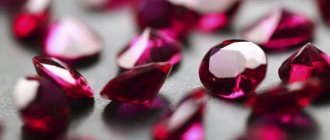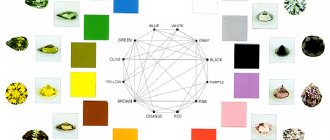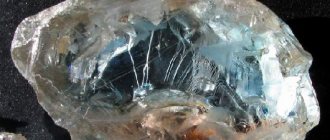Hyacinth color
Gemstones and Minerals / Hyacinth
Hyacinth is a light, transparent variety of yellow-red to orange-red zircon. The name hyacinth has been known since antiquity and is explained by the similarity of the color of the stone and the flower of the same name; is now rarely used because the name has been found to combine different types of stones of the same or similar color. Pliny placed the hyacinth immediately after the amethyst:
. Hyacinth differs significantly from it (amethyst). the shining purple shine of amethyst in hyacinth is dull. At first glance it is pleasant, but it disappears before it can satisfy the eyes, because it does not fill the eye, but barely touches it and fades even faster than the flower of the same name. (Book XXXVII, Chapter LII).
From the description it follows that Pliny's hyacinth is rose quartz, which, as is known, fades in the light. Solinus (Col. XXX, 32) describes hyacinth. like a purple stone or blue water (apparently, they meant transparent sapphire - author's note). This is the description most often found in medieval authors. The greatest confusion in the description of hyacinth was introduced by Constantine the African (Degradibus liber, Opera p. 352), who, translating Lap > stones - corundums (sapphires). The same is the case with Arnold (De finibus rerum naturalium) and others. Albertus Magnus distinguishes three varieties of hyacinth: aquaticus (watery), sapphirinus (sapphire) and topazion: . Water hyacinth is pale blue in color, as if clear water is spilling from its transparent depths. It is less valuable. It also has a watery red color, in which the transparency of the water predominates. Sapphirinus is light blue, without a watery tint; he is very valuable. Topazion is unusually hard and rather not valuable, since it is difficult to engrave. (Book of Minerals, Treatise II, Chapter 8). This division remained until the end of the 18th century. Hyacinth is a blood-red zircon, a stone of unhappy love. Young women with hyacinth rings risk losing their lovers. But it is also a stone of hope and transformation, which helps to calm down and get out of a state of melancholy and depression. In the East, they believe that hyacinth can improve the mental abilities of its owner, increases intelligence and improves memory.
The name by which many people know the fragrant flower also belongs to a wonderful jewelry stone.
Compound . By origin it belongs to the igneous deep. Hyacinth is a variety of zirconium Zr[SiO4].
Physical properties . There are orange, red, pink and raspberry-purple hyacinths. The orange, reddish shades of hyacinth are due to defects in the crystalline structure of zircon associated with the admixture of yttrium and other rare earth elements.
Hyacinth has a bright diamond luster and a fairly high hardness, up to 7.5 on the Mohs scale. The transparency of the stone is quite high.
Features of education . Zircon is formed in different conditions, but its largest crystals are found in pegmatite veins.
Deposits where transparent orange, pink and red hyacinths are found are known in Sri Lanka, Thailand, Australia and Madagascar. Our Omsk region can also be proud of the zircon-ilmenite ore deposit, which is located near the most ancient city of our region, the city of Tara.
It was in zircon that the German chemist Martin Klaproth discovered a new chemical element called zirconium. Already in the mid-70s. In our century, oxide crystals of this element with various additives were synthesized. As a result, a whole family of multi-color artificial cubic zirconia gemstones appeared.
According to the Revelation of John the Theologian, hyacinth is one of the 12 biblical precious stones that adorn the base of the walls of Heavenly Jerusalem. The Indians, who called this stone Rahuratka, dedicated it to the legendary dragon, which caused eclipses of the Sun and Moon. In the Middle Ages, hyacinth was considered the patron saint of merchants and artists.
Anthocyanins: secrets of color
O. Yu. Shoeva, Candidate of Biological Sciences
“Chemistry and Life” No. 1, 2013
Several centuries ago, one of the most interesting and beautiful stories in biological science began - the history of the study of color in plants. Plant pigments anthocyanins played an important role in the discovery of Mendel's laws, mobile genetic elements, RNA interference - all these discoveries were made through observations of plant color. To date, the biochemical nature of anthocyanins, their biosynthesis and its regulation have been studied in sufficient detail. The data obtained makes it possible to create unusually colored varieties of ornamental plants and agricultural crops. The blue rose is no longer a fairy tale.
What are anthocyanins? A little about chemistry
Rice. 1.
Potato variety “Chudesnik”, which was bred by Ural breeders (photo courtesy of E. P. Shanina)
Recently, in Russian and foreign media there have often been reports of miracle fruits, miracle vegetables and miracle flowers with unusual colors, which either are not found in these plant species, or are found, but very rarely. A furore among the Russian public was recently created by the news about a new potato variety, “Chudesnik,” with purple colored flesh, created by breeders from the Ural Research Institute of Agriculture (Fig. 1). Among the vegetables with an unusual purple color we can also mention cabbage, peppers, carrots, and cauliflower. Note that all varieties of purple vegetables, fruits and cereals approved for cultivation for commercial purposes were created during breeding work; these are not genetically modified varieties.
Another example is the blue rose, the dream of more than one generation of breeders and gardeners. Until 2004, blue rose buds could only be obtained using chemical dyes, such as indigo, which were injected into the roots of a white rose (see Chemistry and Life, 1989, No. 6). In 2004, a true blue rose was obtained for the first time in the world using genetic engineering methods (Fig. 2).
These and other bold color manipulations, which the press calls “miracles,” were made possible thanks to comprehensive research into the nature of anthocyanin pigmentation and the genetic component of the biosynthesis of anthocyanin compounds.
Rice. 2.
The world's first blue rose, created by Australian scientists with the support of the Japanese holding Suntory
Today, plant pigments such as flavonoids, carotenoids and betalains have been studied quite well. Everyone knows carrot carotenoids, and betalains include, for example, beet pigments. The group of flavonoid compounds makes the greatest contribution to the diversity of color shades in plants. This group includes yellow aurones, chalcones and flavonols, as well as the main characters of this article - anthocyanins, which color plants pink, red, orange, scarlet, purple, blue, dark blue. By the way, anthocyanins are not only beautiful, but also very useful for humans: as it turned out during their study, they are biologically active molecules.
So, anthocyanins are plant pigments that can be present in plants both in generative organs (flowers, pollen) and vegetative organs (stems, leaves, roots), as well as in fruits and seeds. They are constantly contained in the cell or appear at a certain stage of plant development or under stress. The latter circumstance led scientists to believe that anthocyanins are needed not only to attract pollinating insects and seed dispersers with their bright colors, but also to combat various types of stress.
The first experiments on the study of anthocyanin compounds and their chemical nature were carried out by the famous English chemist Robert Boyle. Back in 1664, he first discovered that under the influence of acids the blue color of cornflower petals changes to red, while under the influence of alkali the petals turn green. In 1913–1915, the German biochemist Richard Willstätter and his Swiss colleague Arthur Stoll published a series of papers on anthocyanins. They isolated individual pigments from the flowers of various plants and described their chemical structure. It turned out that anthocyanins are found in cells mainly in the form of glycosides. Their aglycones (basic precursor molecules), called anthocyanidins, are associated primarily with the sugars glucose, galactose, and rhamnose. “For his research on the coloring substances of the plant world, especially chlorophyll,” Richard Willstätter was awarded the Nobel Prize in Chemistry in 1915.
More than 500 individual anthocyanin compounds are known, and their number is constantly increasing. All of them have a C15-carbon skeleton - two benzene rings A and B, connected by a C3 fragment, which forms a γ-pyrone ring with an oxygen atom (C-ring, Fig. 3). At the same time, anthocyanins differ from other flavonoid compounds by the presence of a positive charge and a double bond in the C-ring.
Rice. 3.
Basic structure of anthocyanidins and anthocyanins. Carbon atoms are numbered
With all their enormous diversity, anthocyanin compounds are derivatives of only six main anthocyanidins: pelargonidin, cyanidin, peonidin, delphinidin, petunidin and malvidin, which differ in the side radicals R1 and R2 (Fig. 3, table). Since during biosynthesis peonidin is formed from cyanidin, and petunidin and malvidin are formed from delphinidin, three main anthocyanidins can be distinguished: pelargonidin, cyanidin and delphinidin - these are the precursors of all anthocyanin compounds.
Modifications of the basic C15-carbon skeleton create individual compounds from the class of anthocyanins. As an example in Fig. Figure 4 shows the structure of the so-called sky blue anthocyanin, which colors morning glory flowers blue.
Rice. 4.
Structure of sky blue anthocyanin.
The compound is isolated from the bindweed Ipomoea tricolor
.
Peonidin (methylated cyanidin derivative) is marked
in blue green
—residues of caffeic acid;
black
- glucose residues. Picture: "Schroeder Group" from www.bblogk.uni-freiburg.de. Photo: E. Russell
Possible options
What color anthocyanins color a plant depends on many factors. First of all, color is determined by the structure and concentration of anthocyanins (it increases under stress conditions). Delphinidin and its derivatives are blue or blue, pelargonidin derivatives are red-orange, and cyanidin is purple-red (Fig. 5). In this case, the blue color is caused by hydroxyl groups (see table and Fig. 4), and their methylation, that is, the addition of CH3 groups, leads to redness (“ International Journal of Molecular Sciences
", 2009, 10, 5350–5369, doi:10.3390/ijms10125350).
Rice. 5.
Flowers of various varieties of eustoma with a predominance of pigments - derivatives of pelargonidin (
left
), cyanidin (
center
) and delphinidin (
right
).
From the book “ Anthocyanins: biosynthesis, functions, and applications
” (Springer, 2008)
In addition, pigmentation depends on the pH in the vacuoles where anthocyanin compounds accumulate. The same compound, depending on the shift in the acidity of the cell sap, can acquire different shades. Thus, a solution of anthocyanins in an acidic environment is red, in a neutral environment it is purple, and in an alkaline environment it is yellow-green.
However, the pH in vacuoles can vary from 4 to 6, and, therefore, the appearance of a blue color in most cases cannot be explained by the influence of the pH of the environment. Therefore, additional studies were carried out, which showed that anthocyanins in plant cells are not present in the form of free molecules, but in the form of complexes with metal ions, which are precisely blue in color (“ Nature Product Reports
", 2009, 26, 884–915). Complexes of anthocyanins with ions of aluminum, iron, magnesium, molybdenum, tungsten, stabilized by copigments (mainly flavones and flavonols) are called metalloanthocyanins (Fig. 6).
Rice. 6.
Scheme of the formation of metalloanthocyanin from six molecules of anthocyanin, a flavone and two metal ions.
On the right
is the spatial structure of protocyanin isolated from cornflower petals (from:
Natural Products Reports
, 2009, 26, 884–915)
The localization of anthocyanins in plant tissues and the shape of epidermal cells are also important, since they determine the amount of light reaching the pigments, and therefore the color intensity. It has been shown that snapdragon flowers with conical-shaped epidermal cells are brighter colored than the flowers of mutant plants, the epidermal cells of which cannot take such a shape, although both plants produce anthocyanins in the same amount (" Nature
», 1994, 369, 6482, 661–664).
So, we told you what causes the shades of anthocyanin pigmentation, why they are different in different species or even in the same plants under different conditions. The reader can experiment with his own house plants, observing the change in their colors. Perhaps in the course of these experiments you will achieve the desired shade of color and your plant will survive, but it certainly will not pass on this shade to its descendants. For the effect to be heritable, it is necessary to understand one more aspect of color formation, namely the genetic component of anthocyanin biosynthesis.
Genes for blue and purple
The molecular genetic basis of anthocyanin biosynthesis has been studied quite fully, which has been greatly facilitated by mutants of various plant species with altered coloration. Anthocyanin biosynthesis, and therefore color, is affected by mutations in three types of genes. The first is genes that encode enzymes involved in the chain of biochemical transformations (structural genes). The second is genes that determine the transcription of structural genes at the right time in the right place (regulatory genes). Finally, the third is the genes of transporters that transport anthocyanins into vacuoles. (Anthocyanins in the cytoplasm are known to oxidize and form bronze-colored aggregates that are toxic to plant cells ( Nature
», 1995, 375, 6530, 397–400).)
Today, all stages of anthocyanin biosynthesis and the enzymes that carry them out are known and studied in detail using the methods of biochemistry and molecular genetics (Fig. 7). Structural and regulatory genes for anthocyanin biosynthesis have been isolated from many plant species. Knowledge of the characteristics of the biosynthesis of anthocyanin pigments in a particular plant species allows one to manipulate its color at the genetic level, creating plants with unusual pigmentation that will be passed on from generation to generation.
Rice. 7.
Biosynthesis of anthocyanidins: cyanidin, pelargonidin, delphinidin.
Anthocyanidins are further subjected to modification reactions - glycosylation, acylation, methylation, which are carried out by glycosyltransferases (GT), acyltransferases (AT) and methyltransferases (MT). The typical color of anthocyanins formed from the above anthocyanidins is shown in the figure, but it depends on many factors: pH, copigmentation with colorless flavonoids, complexes with heavy metal ions. Note that it
is anthocyanins, not anthocyanidins, that undergo
blue dashed arrows Abbreviations: chalcone synthase (CHS); chalcone flavanone isomerase (CHI); dihydroflavonol 4-reductase (DFR); flavanone 3-hydroxylase (F3H); flavonoid 3'-hydroxylase (F3'H); flavonoid 3′,5′-hydroxylase (F3'5'H); anthocyanidin synthase (ANS); flavone synthase (FNS); flavonol synthase (FLS) (from: International Journal of Molecular Sciences
, 2009, 10, 5352)
Selection and genetic modification
The hot spots for color modification in plants are mainly structural and regulatory genes. The methods by which the color of plants can be modified are divided into two types. The first includes selection methods. The selected plant species receives genes through crossing from donors - plants of a closely related species that have the desired trait. The “Chudesnik” potato variety, according to its author, head of the potato breeding department of the State Scientific Institution of the Ural Research Institute of Agriculture, Doctor of Agricultural Sciences E. P. Shanina, was created precisely by the selection method.
Another striking example is wheat, which has purple and blue grain colors due to anthocyanins (Figure 8). In the wild, wheat with purple grain was first discovered in Ethiopia, where this trait apparently appeared, and then the genes responsible for it were introduced by breeding methods into cultivated varieties of bread wheat. Wheat with blue grains does not occur in nature, but a relative of wheat, wheatgrass, has blue grains. By crossing wheatgrass and wheat and selecting for this trait, breeders obtained wheat with blue grain (“ Euphytica
», 1991, 56, 243–258).
Rice. 8.
Purple (
left
), blue (
right
), and undyed (
center
) grains of wheat.
" Metro News
" from metronews.ca
In these examples, regulatory genes were introduced into the wheat genome. In other words, wheat has a functional apparatus for anthocyanin biosynthesis (all enzymes necessary for biosynthesis are in order). Regulatory genes obtained from related species only trigger the “anthocyanin biosynthesis machine” in wheat in the grain.
Rice. 9.
Tomatoes with a high content of anthocyanins in fruits, obtained by genetic engineering
A similar example, but using the second group of color manipulation methods - genetic engineering methods - is the production of tomatoes with a high content of anthocyanins (" Nature Biotechnology
", 2008, 26, 1301–1308, doi:10.1038/nbt.1506). Normally, ripe tomatoes contain carotenoids, including the fat-soluble antioxidant lycopene; among the flavonoids, naringenin chalcone (2′,4′,6′,4-tetrahydroxychalcone, see Fig. and rutin (glycosylated 5,7 ,3′,4′-tetrahydroxyflavonol). By introducing into plants a genetic construct containing the regulatory genes for the biosynthesis of snapdragon anthocyanins
Normally, ripe tomatoes contain carotenoids, including the fat-soluble antioxidant lycopene; among the flavonoids, naringenin chalcone (2′,4′,6′,4-tetrahydroxychalcone, see Fig. and rutin (glycosylated 5,7 ,3′,4′-tetrahydroxyflavonol). By introducing into plants a genetic construct containing the regulatory genes for the biosynthesis of snapdragon anthocyanins
Ros1
and
Del
under the control of the E8 promoter, active in tomato fruits, an international group of scientists obtained tomatoes with a high content of anthocyanins - an intense purple color ( Fig. 9).
These were all examples of manipulation of regulatory genes. An example of the use of genetic engineering to change color due to structural genes for anthocyanin biosynthesis is pioneering work carried out in the 80s by German scientists on petunia (" Nature
", 1987, 330, 677–678, doi:10.1038/330677a0). For the first time in history, the color of a plant was changed using genetic engineering methods.
Normally, the petunia plant does not contain any pigments derived from pelargonidin. To understand why this happens, let's return to Fig. 7. For the DFR enzyme (dihydroflavonol-4-reductase) of petunia, the most preferred substrate is dihydromyricetin, less preferred is dihydroquercetin, and dihydrokaempferol is not used at all as a substrate. A completely different picture of the substrate specificity of this enzyme is found in corn, the DFR of which “prefers” dihydrokaempferol. Armed with this knowledge, Meyer used a mutant petunia line that lacked the F3'H and F3'5'H enzymes. Looking at Fig. 7, it is easy to guess that this mutant line accumulated dihydrokaempferol. What happens if you introduce a genetic construct containing the Dfr
corn? An enzyme will appear in petunia cells that, unlike the “native” DFR of petunia, is capable of converting dihydrokaempferol into pelargonidin. It was in this way that the researchers obtained petunia with an uncharacteristic brick-red color of flowers (Fig. 10).
Rice.
10. On the left
is a mutant line of petunia with a pale pink color of the corolla due to the presence of trace amounts of anthocyanins - derivatives of cyanidin and delphinidin,
on the right
- a genetically modified petunia plant that accumulates anthocyanins - derivatives of pelargonidin (
Nature
, 1987, 330, 677–678)
However, researchers do not always have such convenient mutants at hand, so most often when modifying the color of plants they have to “turn off” unnecessary enzymatic activity and “turn on” the one that is needed. This is exactly the approach that was used to create the world's first rose with blue buds (Fig. 2, 11).
Rice. eleven.
Scheme for creating a blue rose. Ordinary roses do not produce dihydromyricetin, so their color does not have shades of blue. In a blue rose, on the contrary, the formation of red and orange pigments is disabled
In roses created through the efforts of breeders, the color of the petals varies from bright red and soft pink to yellow and snow-white. Intensive studies of anthocyanin biosynthesis in roses have revealed that they do not have F3'5'H activity, and the rose DFR enzyme uses dihydroquercetin and dihydrokaempferol, but not dihydromyricetin, as substrates. Therefore, when creating a blue rose, scientists chose the following strategy. At the first stage, the rose’s own DFR enzyme was “turned off” (for this, an approach based on RNA interference was used), at the second stage, a gene encoding the functional F3'5'H of pansies (viola) was introduced into the rose genome, at the third stage it was added Dfr gene
iris, which encodes an enzyme that produces delphinidin, a blue-colored precursor of anthocyanins, from dihydromyricetin. At the same time, to prevent the F3'5'H enzymes of pansies and F3'H of roses from competing with each other for the substrate (that is, for dihydrokaempferol, Fig. 7), a genotype with the absence of F3'H activity was chosen to create a blue rose.
Another example of the amazing possibilities that accumulated data on the biosynthesis of flavonoid pigments in combination with genetic engineering methods opens up for us is the production of torenia plants with yellow flowers (Fig. 12).
Rice. 12.
Scheme of biosynthesis of anthocyanins and aurones.
Below are
flowers of ordinary torenia, accumulating anthocyanins (
left
), and transgenic, accumulating aurones (
right
).
Designations: THC
- tetrahydroxychalcone,
PHC
- pentahydroxychalcone
It is known that two types of pigments have a yellow color: aurones, a class of pigments of flavonoid nature that color snapdragon and dahlia flowers bright yellow, and carotenoids, pigments of tomato and tulip flowers. It was found that aurones in snapdragons are synthesized from chalcones through two enzymes - 4'CGT (4'chalcone glycosyltransferase) and AS (aureusidine synthase). Introduction of genetic constructs with 4'Cgt
and
As from
snapdragons in torenia plants (which normally have blue flowers), together with inhibition of the biosynthesis of anthocyanin pigments, led to the accumulation of aurones, and, consequently, the flowers of such a plant turned out to be bright yellow.
A similar strategy can be used to produce yellow flowers not only in torenia, but also in geranium and violet ( Proceedings of the National Academy of Sciences USA
, 2006, 103, 29, 11075–11080, doi:10.1073/pnas.0604246103) .
The examples given are only a small part of the manipulations that scientists today perform with the biosynthesis of anthocyanins. All this became possible thanks to research into the biochemical nature of pigments, as well as the characteristics of their biosynthesis in various plant species, both at the enzyme level and at the molecular genetic level. The knowledge accumulated to date about anthocyanin compounds has opened up inexhaustible possibilities for creating ornamental plants with unusual colors, as well as cultivated plant species with a high content of anthocyanin pigments. And although the achievements of selection - unusually colored vegetables and fruits - are already available to buyers in some countries, ornamental plants created using genetic engineering methods are still rare. Due to a number of unresolved difficulties, such as the stability of inheritance of modified color, they have not yet been commercialized (with the exception of some varieties of petunia, blue rose, lilac carnation). However, work in this direction continues. Let's hope that soon there will be pleasing “miracles of science” available to all lovers of beauty.
What else can you read about anthocyanins:
Karabanov I.A.
Flavonoids in the plant world.
- Minsk: Urajai, 1981. Andersen OM, Jordheim M.
The anthocyanins // Andersen OM, Markham KR (Eds.).
Flavonoids: chemistry, biochemistry and applications. - Boca Raton, FL: CRC Press, 2006, 452–471. Mol J., Grotewold E., Koes R.
How genes paint flowers and seeds // Trends Plant Sci. 1998, 3, 212–217.
Facts and legends about the stone
There are several beautiful legends about the appearance of hyacinth.
- The sad myth about the beautiful Hyacinth , a Greek youth, tells that he was friends with the god of art Apollo. But one day, when the competition was held, Apollo launched a disk and it hit Hyacinth. The young man died from his wounds. And from the blood that flowed from the wound, amazing gems were formed, which received the name of the deceased handsome man.
- An ancient Indian legend says that the hyacinth stone came to our world from the disappeared Lemuria. Even before people appeared on Earth, this continent was located in the place where the Indian Ocean is now located.
Healers in the Middle Ages sold bags of hyacinth mixture, which contained dried plant parts and hyacinth particles. It was believed that if you constantly wear such a talisman, it will have a beneficial effect on the general condition of a person, regardless of his age.
The Russian nobility was also familiar with the precious stone. The richer the family was, the higher quality yaquintes were stored in its boxes. Merchants especially loved this gem. After all, there was a belief that the brighter the shine of the crystal, the more honest its owner.
History and origin of the name
The name “hyacinth” is not only a gemstone, but also a flower. They are united not only by the shade of red called “hyacinth,” but also by the legends surrounding their origin.
The Spartan king Amycles had a son, Hyacinth. For some reason, both mortals and gods, but of the same gender, fell in love with the handsome young man. Apollo, the sun god, also saw him. He fell in love, eliminated the rival of the poet Thamyris, persuading the muses to deprive him of his voice, and began to spend time with the young man hunting in the Eurotas Valley. And then one day on a hot afternoon, Apollo and Hyacinth decided to compete in discus throwing. As was customary in Ancient Greece, they undressed, anointed themselves with olive oil and began the competition. The young man turned out to be skillful and in no way inferior to his divine patron.
But to Hyacinth’s misfortune, the god of the southern wind Zephyr flew past, also not indifferent to the young man. Zephyr blew away the disk thrown by Apollo so that he would not get the victory, but at the same time the disk hit Hyacinth's head. The young man died in the arms of the inconsolable Apollo. To preserve the memory of his beloved, he created a beautiful hyacinth flower from drops of his blood. Zephyr, too, could not find a place for himself and gently caressed its petals. When autumn came, the fallen petals turned into beautiful gems. According to another version of the legend, drops of blood first turned to stone, and only then a red flower appeared.
The ancient Indians called the stone “rahuratka” and hoped to use it to appease the dragon that swallows the sun during eclipses. It was believed that the stone came to India from the disappeared continent of Lemuria.
In honor of Hyacinth, Hyacinthias were held in Greece - annual holidays, on the first day of which everyone mourned the death of the beautiful young man, and then indulged in fun and held competitions.
Interesting: Hyacinth is mentioned in the Apocalypse among the stones that will form the foundation of the Heavenly Jerusalem.
Pliny also mentioned it, but which stone was meant is not always clear, because until the 19th century, all orange-colored stones were called hyacinths, just as all red ones were referred to as rubies, and blue ones were referred to as sapphires.
In Rus', the stone was known under the names “jargon”, “ligurium”, “yacinth” and “yacinth”, but most often it was simply called “topaz”.
The word "slang" means "fake stone" because zircon and hyacinth are similar to diamond or ruby.
In 1789, German chemist Martin Klaproth claimed to have discovered new “earth,” as metal oxides were then called, in zircons from Sri Lanka. Zirconium itself was not obtained soon. Humphry Davy, who electrochemically obtained many previously unknown metals, failed to cope with this task.
It was only in 1824 that zirconium was obtained by Bercellius. And the industrial method of obtaining it appeared only a century later. The need for this metal and its compounds is constantly increasing, since the metal has found applications in the nuclear and space industries, in medicine, dental and joint prostheses are made from it, and in pyrotechnics for fireworks and lighting rockets. The metal is extremely resistant to corrosion, which is why dishes and chemical reactors are made from it.
Zirconium dioxide is also useful for jewelers. It is from this that cubic zirconias, artificial stones that shine like diamonds, are obtained. Therefore, they can be considered highly modified zircons, of which hyacinth is a variety.
Characteristics of the mineral
Hyacinth is a gemstone, a type of zircon. In nature it is found in small sizes. It is rarely possible to find specimens larger than one or two centimeters. If the gem is exposed to high temperature for a long time, it will become transparent and look like a diamond. This also accounts for its high popularity among jewelers.
Varieties and colors
The color of the mineral may be similar to dried blood, red, orange, yellow or pink. There are varieties that resemble sapphire and garnet. Very rarely nature gives bluish crystals.
Red-brown hyacinth looks expensive and sophisticated. Amulets with it can give the owner a philosophical view of the world. The yellow crystal looks like a bright sunbeam, having shades from lemon to dark honey. Jewelry with it is suitable for optimists who are capable of active action.
Scope and cost
Jewelry with hyacinth is so beautiful and visually attractive that it can complement the image of any person, regardless of his gender.
- A ring with hyacinth is a very popular piece of jewelry for both women and men. It can be worn every day and on special occasions. Engagement rings with a yaquinta inset surrounded by a clear zircon gemstone are especially stunning.
- For pendants, craftsmen sometimes set the mineral in precious metals or use it as an independent decoration. Also, pendants can become a strong amulet against the unkind gaze of envious people.
- Gold or silver earrings with hyacinth can decorate the ears of both a young girl and a mature lady. A scattering of amethysts around the stone will only emphasize its radiance and splendor.
- Bracelets made of hyacinth framed with cupronickel can be worn by the fair half of humanity not only on the arm, but also on the leg. And then the lady will be able to feel protected from the negative energy of ill-wishers.
The price of jewelry with a mineral depends on its color and quality. For a ring made of silver with cognac-colored yaquinte, you will have to pay about 100 euros. And the cost of silver earrings can reach 150 euros.
History and origin
There is a legend about the origin of the stone. It talks about the handsome young man Hyacinth, with whom Apollo and Zephyr were friends.
One day, Apollo and Hyacinth decided to measure their strength and dexterity. God threw the disk, and Zephyr, dreaming of the victory of his favorite, rejected it, but unsuccessfully. The disk hit the handsome young man's head and killed him. In memory of his friend, Apollo turned drops of his blood on the ground into beautiful flowers, which, petrified, turned into precious crystals. Both the flowers and the crystals were called hyacinth.
The crystal is also mentioned in religion. In the New Testament it is spoken of as one of the stones that decorate the wall of Heavenly Jerusalem. In Christianity, hyacinth is dedicated to the Apostle Simeon.
In ancient books, this stone appears under other names: yacinth, ligurium, yacinth and jargon.
Healing qualities
Since ancient times, people have honored and respected hyacinth for its medicinal properties. Modern lithotherapists believe that it is the unprocessed gem that can cure a person of any diseases of the eyes and skin. It is enough to contact the healing mineral 2-3 times a day.
The stone can cure a person from such ailments as:
- weak heart;
- frayed nerves;
- depression;
- sleep problems, including insomnia;
- ulcers and stomach upsets.
Magical power and meaning
Already in ancient centuries, alchemists knew what powerful magical properties the crystal had.
- People wearing hyacinth amulets notice that it has become easier for them to find contact with those people who can help them achieve success.
- Many modern healers claim that the stone can increase the intellectual abilities of its owner. A person becomes more inquisitive, and his memory improves under the influence of the gem.
- There is still a sign that a person must wear an amulet with a mineral on the road. The crystal is able to protect its owner for a long time from negative energy that can come from other people. Magicians assure that evil spirits and vengeful ancestors will also not be able to interfere with the owner of hyacinth.
- Modern dream books claim that if a person dreams that he is wearing a piece of jewelry with hyacinth, then an event will soon occur that will bring a lot of positive emotions.
Magnificent hyacinths - meaning, color symbolism
The symbolism of flowers has deep meaning.
People began to interpret the meaning of flowers a very long time ago, noting the characteristics and magical properties of each plant. It is worth mentioning separately the fragrant and aristocratic chic hyacinths in bouquets. Flowers can help us express emotions and feelings without words. Flowers are widely represented in painting and poetry, folk medicine and interior design.
Certain varieties of flowers can only be given as gifts to certain people.
Recommendations for care and storage
Yaquint will be able to retain its charm for a very long time if the owner follows certain rules.
- The product should not be stored in light or brought near fire, otherwise the color of the crystal will change.
- It is necessary to protect the stone from moisture and exposure to household chemicals. Therefore, jewelry should be removed before washing your hands.
- Sometimes it is worth wiping the mineral with a dry cotton cloth.
The hyacinth stone has been of great importance in people's lives throughout the centuries. Despite all the superstitions that only a strong person can possess a gem, not only rich people, but also poor people wanted to own it. But only a select few were able to buy a natural mineral. And low-income representatives of human society could only admire the flowers of the same name.
Originally posted 2018-03-04 14:48:02.
Who is hyacinth stone suitable for according to their zodiac sign?
There are no zodiac signs for which hyacinth is contraindicated. However, the effect of the mineral on different people is still different. Thus, Aries climb the career ladder, find mutual understanding with their superiors, and protect them from envious people.
With its help, it will become easier for Taurus , Scorpio , Capricorn They will gain motivation and desire to move towards their goal. Tenacity and perseverance, coupled with the hyacinth effect, will definitely lead these signs to success.
Cancers , Leos , Virgos will be able to begin to attract the opposite sex. It will also be easier for such people to start a family or at least a serious relationship. If you have several candidates, the stone will indicate the most suitable one.
Gemini , Sagittarius , Aquarius , Pisces will learn to value friendship and reduce conflict. It will become easier for them to make friends. The stone can also attract pleasant situations and new acquaintances if a person suffers from routine and loneliness.
Hyacinth
Hyacinth is a very beautiful stone - it has a diamond shine and good transparency, it is a type of zircon. In addition, hyacinth has very high hardness, for which jewelers highly value this gemstone.
The stone also has other names - yaquint, peradol, hyacinth topaz, slang, ligurium, rahuratka.
The color of hyacinth is usually orange, red, raspberry-purple, pink, and brown. And blue hyacinths are very rarely found (you should be careful with these, as you can artificially achieve a blue color - for this, brown hyacinths are subjected to heat treatment).
He got his name in honor of the hyacinth flower, which in turn was named in honor of the ancient Greek hero Hyacinth, whose blood drops were turned into flowers by Apollo.
It has long been known to mankind. True, this stone was often confused with sapphires, quartz or topaz. Later, only the red variety of zircon began to be called hyacinth (maybe because these stones were similar in color to coagulated blood). Among some peoples, hyacinths were valued very highly - on a par with diamonds, chrysolites and emeralds. And in the Revelation of John the Theologian it is indicated that hyacinth, along with eleven other precious stones, adorns the walls of Heavenly Jerusalem.
However, since ancient times they have also made decoys from hyacinth. For example, they “burned” hyacinths until they were completely transparent and sold them as diamonds, since hyacinth is a strong stone and its iridescence is very similar to diamond.
The most famous hyacinth deposits are located in Thailand, Sri Lanka, Australia, Madagascar and Russia (there are excellent zircon-ilmenite ores in the Omsk region).
Magic properties
Since ancient times, hyacinth has been considered a good talisman, especially for merchants. It was believed that this gemstone brings good luck, increases wealth, and can also help recognize lies. It was also considered a good talisman for travelers - it protected against various misfortunes and made the journey easier. People also believed that hyacinth was very good for creative people - it helped them to reveal their talents and helped them gain fame. And in the East it was believed that hyacinth developed mental abilities. And one of the interesting magical properties of hyacinth was the belief that this gem is able to extinguish the flame (if the hyacinth is thrown into the fire) and protect from lightning. And it is also not recommended for young girls and unmarried ladies to wear hyacinth - otherwise they may lose their lovers.
Medicinal properties
According to some beliefs, it helps preserve youth, relieves nightmares, improves sleep (hyacinth was even called the “gem sleeping pill”), treats the circulatory system, heart, spleen, improves vision (for which hyacinth was called the “stone for blindness”), helps during stress , depression, melancholy and overstrain, accelerates wound healing, improves digestion processes. It was even believed that hyacinth would help against unwanted conception (although it is better for pregnant women to stay away from hyacinth, otherwise this stone can cause a miscarriage). In the Middle Ages, they sold a special elixir “for all diseases” - a hyacinth mixture with crushed hyacinth (by the way, Pope Clement VII was treated with it).
Physical properties of hyacinth
Color blindness or color blindness
Color blindness, also known as color blindness, is an impairment of color vision, i.e. ability to see colors or see differences between them. People with this disease, under certain circumstances or against certain backgrounds, have difficulty seeing objects, combining colors (for example, when choosing clothing), or working with color codes, such as graphical user panels on computers. Color blindness is a general term that includes several specific conditions. Here you will find information about how Hyacinth blue is seen by people with different types of color blindness.
Monochromacy
Monochromasia is the inability to distinguish any colors other than one narrow part of the light spectrum. In other words, people with monochromasia can only distinguish between lighter and darker shades of the same color.
Achromatopsia
For people with achromatopsia, i.e. inability to see anything other than black, white and gray, Hyacinth Blue appears as the color code rgb(166, 166, 166), which can be seen next to this description
. The effect of this disease is similar to the condition when a person sees everything in black and white.
When ordering a design that may be used by people with color vision impairment, it is worth consulting with the Arteqo development team, since such projects usually require the development of a separate color palette. One of our priorities is to ensure that our sites are accessible to all users, which in turn influences whether or not Hyacinth Blue should be used in a design.
All about hyacinths: what kind of flower is hyacinth?
One of the early flowering plants in our garden is a flower called hyacinth. Hyacinth is a perennial bulbous plant with a single dense inflorescence-tassel with fragrant flowers. The height of the peduncle can reach 30 centimeters and have a cylindrical or conical inflorescence shape. The regions of Asia Minor and the Eastern Mediterranean are considered the homeland of hyacinth. The hyacinth flower has been known as an ornamental crop since antiquity. Hyacinth gained wide popularity and attention in the 18th century - first in Holland, and then throughout Europe.
Hyacinths - main types
The classification of hyacinths has undergone a number of changes over the long period of their cultivation. What family does hyacinth belong to? At first the flower was classified as a lily, then it was separated into a separate hyacinth family. Currently, the genus of hyacinths is included in the asparagus family and has three main types:
All modern varieties and varieties of hyacinth used in decorative floriculture are descended from the oriental species (Hyacinthus orientalis).
Varieties are represented by a variety of colors, but in nature, the natural color of hyacinth is blue, with a purple tint.
Hyacinth Litvinova
Hyacinth Litvinov (Hyacinthus litwinovii) is a rare, small species. Nowadays it belongs to the Red Book plants. It received its name in honor of the Russian geographer and florist Dmitry Ivanovich Litvinov (1845-1929), who discovered this flower during an expedition. Found in the mountainous regions of Turkmenistan and Eastern Iran.
Litvinov hyacinth bulbs are ovoid and small. This species reaches a height of 15–25 centimeters. Grayish-green wide short leaves are collected in a spreading rosette. The number of short peduncles is from 1 to 2. The elongated, bell-shaped flowers have a rare color: greenish-blue and lilac-blue with a dark stripe in the center of the petals, and are devoid of aroma. There are about 10 flowers in the raceme. The flowering time of this species is in April. Hyacinth Litvinov is the most winter-hardy among the species.
Hyacinth Transcaspian
Transcaspian hyacinth (Hyacinthus transcaspicus) is an endemic perennial plant of the Kopet Dag Range in Turkmenistan. Not found in other regions. Grows high in the mountains. This species is also listed in the Red Book. The height of Trans-Caspian hyacinth is not higher than 20 cm, the leaves are belt-shaped, grassy green in color. Produces one, rarely two peduncles. Bell-shaped flowers of light blue color are collected in a brush of 5-10 pieces. Blooms in May. Prefers shady places. After flowering, the fruit ripens in the form of a box.
Eastern view
Oriental hyacinth (Hyacinthus orientalis) is the most numerous species, the ancestor of all ornamental varieties of hyacinth. It reaches a height of 20 to 35 centimeters. The leaves are belt-shaped, smooth, green and dark green in color. Produces one wide peduncle up to 15 to 20 cm long. Of particular value are the dense large inflorescences, which contain from 20 to 50 flowers on short stalks. The perianth of the eastern hyacinth, depending on the variety, can reach from 4 to 8 centimeters in diameter. The perianth lobes are narrow, pointed towards the end, and curved back. Natural color is blue or white. Currently, thanks to the work of breeders, varieties with pink, orange, yellow, blue and almost black inflorescences are grown. Oriental hyacinth blooms from March to May. The fruit of the eastern hyacinth has the shape of a box with three nests containing a few black seeds.
The bulbs of eastern hyacinth are quite large: about 5-6 centimeters in diameter. The bottom of the bulb (cone-shaped base), in fact, is a shortened stem surrounded by scales that provide nutrition to the plant, accumulating useful substances. Outside, the bulb is protected by dead, thinned scales that have a bluish or pinkish color.
The root system is poorly developed and is represented by several dozen thread-like whitish roots. Hyacinth does not need a developed root system, because nutrients are stored in the scales of the bulb. The poor development of the hyacinth root system is also associated with the short growing season, which occurs in the relatively wet spring period and the natural growing region in the rocky areas of the Balkans and Asia Minor, where the soil layer is thin and shallow.
The growing season of hyacinth is short-term, followed by a long period of dormancy. After flowering, which lasts from one to three weeks, the above-ground part of the plant gradually dies off, and in its place a new flower bud is formed, surrounded by small scales, from which leaves will subsequently develop. Also, after flowering, one or more daughter bulbs form between the scales of an adult bulb, which are used for flower propagation.
HTML Color Options
Hyacinth blue, just like any other color, is a set of numerical parameters that can be displayed using a variety of color models. A color model is an abstract, mathematized system that allows any color to be represented as a set of numerical parameters.
RGB
RGB or Red, Green, Blue is a color model that describes colors as combinations of certain amounts of red, green and blue. This is an additive (from English to add - add) model, i.e. in it, varying amounts of red, green and blue are added to black, which symbolizes the absence of color. Hyacinth blue is composed of 64% red, 64% green and 82% blue. In absolute RGB units (where the minimum is 0 and the maximum is 255) this is 163 red, 163 green and 209 blue. Thus, Hyacinth Blue in the RGB system has the code rgb(163, 163, 209).
RGB graph
Hyacinth blue in the RGB system contains the following number of component colors: Hyacinth blue: amount of red Red Hyacinth blue: amount of green Green Hyacinth blue: amount of blue Blue
CMYK
CMYK or Cyan (cyan, also blue-green), Magenta (magenta or purple), Yellow (yellow), Key (key, also black) is a color model that describes any color as a combination of blue-green, purple and yellow. This is a subtractive model (from English to subtract - take away), within which different amounts of cyan, magenta, yellow and black are subtracted from white - the natural color of paper. Hyacinth blue is composed of 21% blue-green, 21% purple, 0% yellow and 18% black. In other words, Hyacinth Blue in CMYK code is cmyk(21%, 21%, 0%, 18%)
CMYK chart
Hyacinth blue in the CMYK system contains the following number of component colors: Hyacinth blue: amount of cyan Blue-green Hyacinth blue: amount of magenta Purple Hyacinth blue: amount of yellow Yellow Hyacinth blue: amount of black Black
HEX
HEX or hexadecimal color model is a color model that describes colors using six or three (short version, applicable only in certain cases) variables of the hexadecimal number system from 0 to 9 and from the letter a (equal to 10) to the letter f (equal to 15 ). These six symbols are divided into three pairs, where the first two symbols represent red, the middle two represent green, and the last two represent blue. Like the RGB model, the HEX model characterizes colors as a combination of red, green, and blue, with a minimum value of 0 (00 in HEX) and a maximum value of 255 (ff in HEX). Hyacinth blue within this color model has the code A2A2D0.
HSV
HSV or Hue (color group, tone), Saturation (saturation), Value (lightness) is a color model that describes colors as light that belongs to a certain tone (hue, a numerical designation of a part of the visible spectrum) and has saturation (saturation, distance from gray and white) and lightness ( value
, distance from black). Hyacinth blue in the HSV system has the code hsv(240, 0.22%, 0.82%).
HSL
HSL or Hue (color group, tone), Saturation (saturation), Lightness (lightness) is a color model that describes colors as light that belongs to a certain tone (hue, a numerical designation of a part of the visible spectrum) and has saturation (saturation, distance from gray) and lightness ( value
, distance from black, gray and white). Hyacinth blue in the HSL system has the code hsl(240, 33%, 73%).
Safe HTML Colors
HTML safe colors (web safe colors) are a group of 216 colors that in the past were the only colors that were displayed correctly on all modern ( at that time
) monitors and operating systems. This group of colors was defined at a time when monitors could only display 256 colors, and only 216 of them were consistent across all of the most popular operating systems. Nowadays, almost no site uses only safe HTML colors, since such technical restrictions no longer exist. However, if you want to order a site in the style of the 90s, it is worth remembering that Hyacinth blue is not one of the safe HTML colors.
Where do hyacinths grow?
Little known to most non-specialists, Litvinov and Trans-Caspian hyacinths are found only in the natural regions of their growth or in the territories of botanical gardens, where scientists work to preserve these rare plants.
Hyacinth, which is used in ornamental gardening, refers to its oriental species, which has been cultivated for thousands of years. It is still found in the wild in its homeland - the regions of the Eastern Mediterranean, Asia Minor and the Balkans. The “habitat” of domesticated hyacinth is much more extensive. It is bred not only in its usual southern area, but also in Europe and America. Holland is considered the birthplace of hyacinth, whose breeders made an invaluable contribution to the development of this culture. Back in the 18th century, hyacinths came to central Russia, where they successfully adapted to the climate and were planted in open ground in flower beds and gardens. Hyacinths can be found even in the harsh conditions of Scandinavian countries.
Hyacinths are successfully grown as a potted plant at home, in which the growing season of the plant does not change. Flowering lasts about 2 weeks.
Planting and caring for hyacinths in open ground
Site selection
Highly fertile sandy loam and light loamy soils with an acidity of about 6...6.5 are suitable for planting hyacinths. Swampy soils that are flooded in spring and autumn, as well as areas with high groundwater, are completely unsuitable for cultivation. When grown in excessively moist soils, the bulbs will rot: therefore, in damp areas, hyacinths are grown on high ridges.
The area should be well lit by the sun and protected from the wind.
Soil preparation
A month before planting the bulbs, the area is dug up to a depth of at least 20 cm, humus (6...8 kg/m2), double superphosphate (50 g/m2) or the appropriate amount of simple superphosphate, potassium chloride or sulfate (about 120-150 grams per 1 m2). Fresh manure and chicken droppings cannot be introduced.
It must be said that hyacinths will survive without fertilization, but with good nutrition you will get larger inflorescences and larger bulbs.
If the soil is acidic, it makes sense to add about 80 grams of lime per 1 m2. The maximum effect of adding lime will appear only after a year, but in the year of planting it will also slightly reduce acidity.
After digging, large clods of earth are broken up and the area is leveled. Everything as usual.
Landing
In the conditions of central Russia, Belarus, northern Ukraine, etc. The best time to plant hyacinth is late September - early October. In other regions, the planting date should be adjusted based on climatic conditions.
The bulbs are planted bottom down (surprising, right?) with a distance of about 20-30 cm between rows and 10-15 cm between bulbs in a row. The depth of planting depends on the size of the bulbs (the depth from the bottom to the surface of the ground is given):
- with a bulb diameter less than 5 cm - 6...8 cm;
- with a bulb diameter of 5 cm – 10…12 cm
The best results are achieved when planting hyacinths in the so-called. "sand cushion" It looks like this:
- a layer of sand about 3 cm thick is poured onto the bottom of the furrow;
- plant the bulbs by lightly pressing them into the sand;
- sprinkle with a layer of sand, slightly covering the onion;
- covered with earth.
Sand protects the bottom from rotting and reduces the risk of developing bacterial and fungal diseases. At the same time, the mineral nutrition of the plant does not suffer, since the roots very quickly penetrate the sand layer and develop mainly in the fertile soil layer.
After planting, the bulbs should be watered.
Hyacinth care
Autumn
If the autumn is dry, the plantings must be watered regularly to provide conditions for the development of a strong root system. A week before the onset of frost, watering is stopped.
With the onset of persistent cold weather, young plantings must be mulched. For this purpose, you can use dry peat, sawdust, humus, dry leaves, straw, etc.
If the winter has little snow, you need to make sure that the area with hyacinths is covered with snow - it will protect the bulbs during severe frosts. If there is no snow, it is advisable to cover the mulched area with geotextiles.

